HONDA RIDGELINE 2011 1.G Owners Manual
Manufacturer: HONDA, Model Year: 2011, Model line: RIDGELINE, Model: HONDA RIDGELINE 2011 1.GPages: 427, PDF Size: 7.24 MB
Page 361 of 427

Block the rear wheels.
If the vehicle is to be stored f or a
longer period, it should be
supported on jackstands so the
tires are of f the ground.
Leave one window open slightly (if
the vehicle is being stored
indoors).
Disconnect the battery.
Support the f ront wiper blade
arms with a f olded towel or rag so
they do not touch the windshield.
To minimize sticking, apply a
silicone spray lubricant to all door,
In-Bed Trunk lid, and tailgate seals.
Also, apply a vehicle body wax to
the painted surfaces that mate
with the door, In-Bed Trunk lid
and tailgate seals.
If your vehicle’s battery is
disconnected, or goes dead, the time
setting may be lost. To reset the time,
see page .
If your vehicle’s battery is
disconnected or goes dead, the audio
system may disable itself . The next
timeyouturnontheradioyouwill
see ‘‘CODE’’ in the f requency display.
Use the preset bars to enter the code
(see page ).
The navigation system will also
disableitself.Thenexttimeyouturn
on the ignition switch, the system
will require you to enter a PIN
bef ore it can be used. Ref er to the
navigation system manual.
If you need to park your vehicle f or
an extended period (more than 1
month), there are several things you
should do to prepare it f or storage.
Proper preparation helps prevent
deterioration and makes it easier to
get your vehicle back on the road. If
possible, store your vehicle indoors.
Leave the parking brake off. Put
the transmission in Park.
Cleantheinterior.Makesurethe
carpeting, floor mats, etc., are
completely dry.
Wash and dry the exterior
completely.
Fill the f uel tank.
207
206
CONT INUED
On models without navigation system
On models with navigation systemVehicle Storage
Checking the Battery, Vehicle Storage
Maint enance
357
Main MenuTable of Contents
Page 362 of 427

Cover the vehicle with a
‘‘breathable’’ cover, one made
f rom a porous material such as
cotton. Non-porous materials, such
as plastic sheeting, trap moisture,
which can damage the paint.
If possible, periodically run the
engine until it reaches f ull
operating temperature (the
cooling f ans cycle on and of f
twice). Pref erably, do this once a
month.
Vehicle Storage
358
Main MenuTable of Contents
Page 363 of 427

This section covers the more
common problems that motorists
experience with their vehicles. It
gives you inf ormation about how to
safely evaluate the problem and what
to do to correct it. If the problem has
stranded you on the side of the road,
you may be able to get going again.
If not, you will also f ind instructions
on getting your vehicle towed.......................
Compact Spare Tire . 360
....................
Changing a Flat Tire . 361
.............
If the Engine Won’t Start . 369
................................
Jump Starting . 370
..............
If the Engine Overheats . 372
.........
Low Oil Pressure Indicator . 374
..........
Charging System Indicator . 374
.......
Malf unction Indicator Lamp . 375
...............
Brake System Indicator . 376
..............................................
Fuses . 378
..............................
Fuse Locations . 381
......................
Emergency Towing . 383
..........
If Your Vehicle Gets Stuck . 383
Taking Care of the Unexpected
T aking Care of t he Unexpect ed
359
Main Menu
Page 364 of 427
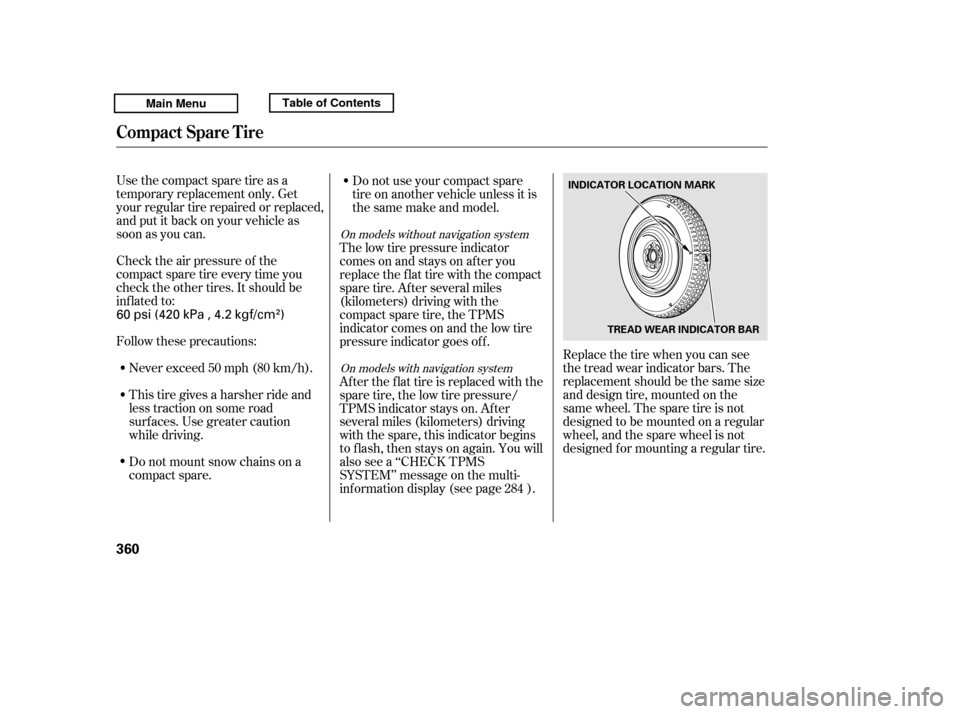
Use the compact spare tire as a
temporary replacement only. Get
your regular tire repaired or replaced,
and put it back on your vehicle as
soon as you can.
Check the air pressure of the
compact spare tire every time you
check the other tires. It should be
inf lated to:
Follow these precautions:Replace the tire when you can see
the tread wear indicator bars. The
replacement should be the same size
and design tire, mounted on the
same wheel. The spare tire is not
designed to be mounted on a regular
wheel, and the spare wheel is not
designed f or mounting a regular tire.
Never exceed 50 mph (80 km/h).
This tire gives a harsher ride and
less traction on some road
surf aces. Use greater caution
while driving.
Do not mount snow chains on a
compact spare. Do not use your compact spare
tire on another vehicle unless it is
thesamemakeandmodel.
The low tire pressure indicator
comes on and stays on af ter you
replace the flat tire with the compact
spare tire. Af ter several miles
(kilometers) driving with the
compact spare tire, the TPMS
indicator comes on and the low tire
pressure indicator goes of f .
After the flat tire is replaced with the
spare tire, the low tire pressure/
TPMS indicator stays on. After
several miles (kilometers) driving
with the spare, this indicator begins
to f lash, then stays on again. You will
also see a ‘‘CHECK TPMS
SYSTEM’’ message on the multi-
inf ormation display (see page ). 284
On models without navigation system
On models with navigation system
Compact Spare Tire
360
INDICATOR LOCATION MARK
TREAD WEAR INDICATOR BAR
60 psi (420 kPa , 4.2 kgf/cm)
Main MenuTable of Contents
Page 365 of 427
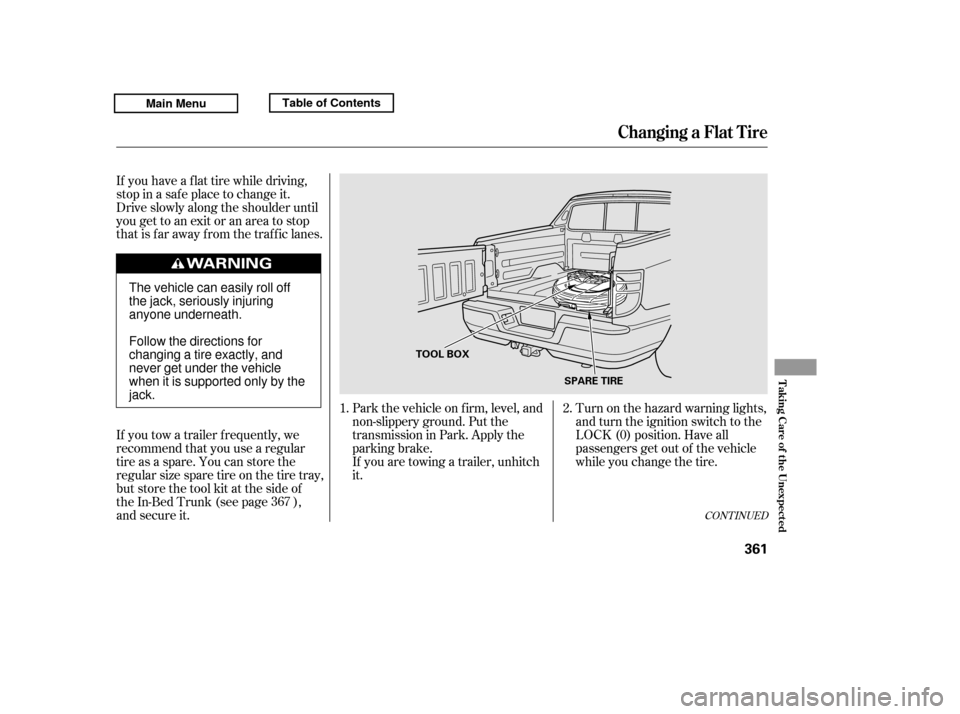
Turn on the hazard warning lights,
and turn the ignition switch to the
LOCK (0) position. Have all
passengers get out of the vehicle
while you change the tire.
Park the vehicle on f irm, level, and
non-slippery ground. Put the
transmission in Park. Apply the
parking brake.
If you are towing a trailer, unhitch
it.
If you have a f lat tire while driving,
stop in a saf e place to change it.
Drive slowly along the shoulder until
you get to an exit or an area to stop
that is far away from the traffic lanes.
If you tow a trailer f requently, we
recommend that you use a regular
tire as a spare. You can store the
regular size spare tire on the tire tray,
but store the tool kit at the side of
the In-Bed Trunk (see page ),
and secure it.
2.
1.
367
CONT INUED
Changing a Flat T ire
T aking Care of t he Unexpect ed
361
TOOL BOX SPARE TIRE
The vehicle can easily roll off
the jack, seriously injuring
anyone underneath.
Follow the directions for
changing a tire exactly, and
never get under the vehicle
when it is supported only by thejack.
Main MenuTable of Contents
Page 366 of 427
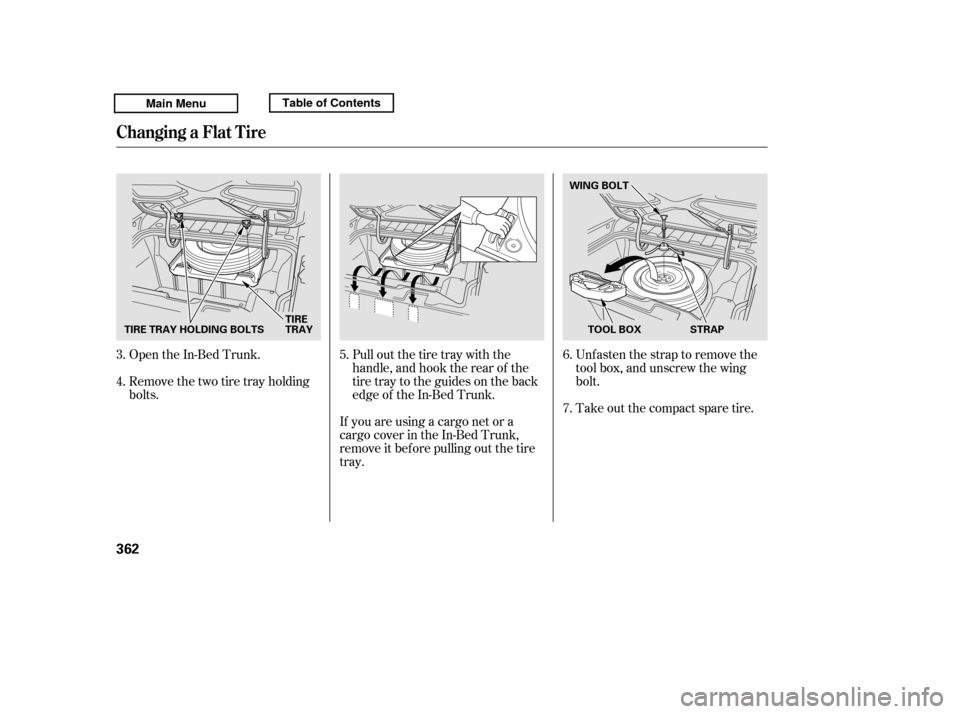
Open the In-Bed Trunk.
Remove the two tire tray holding
bolts.Pull out the tire tray with the
handle, and hook the rear of the
tire tray to the guides on the back
edge of the In-Bed Trunk.Unfasten the strap to remove the
tool box, and unscrew the wing
bolt.
Takeoutthecompactsparetire.
If you are using a cargo net or a
cargo cover in the In-Bed Trunk,
remove it bef ore pulling out the tire
tray.
4.
3.
5.6.
7.
Changing a Flat T ire
362
WING BOLT
TOOL BOX STRAP
TIRE
TRAY
TIRE TRAY HOLDING BOLTS
Main MenuTable of Contents
Page 367 of 427
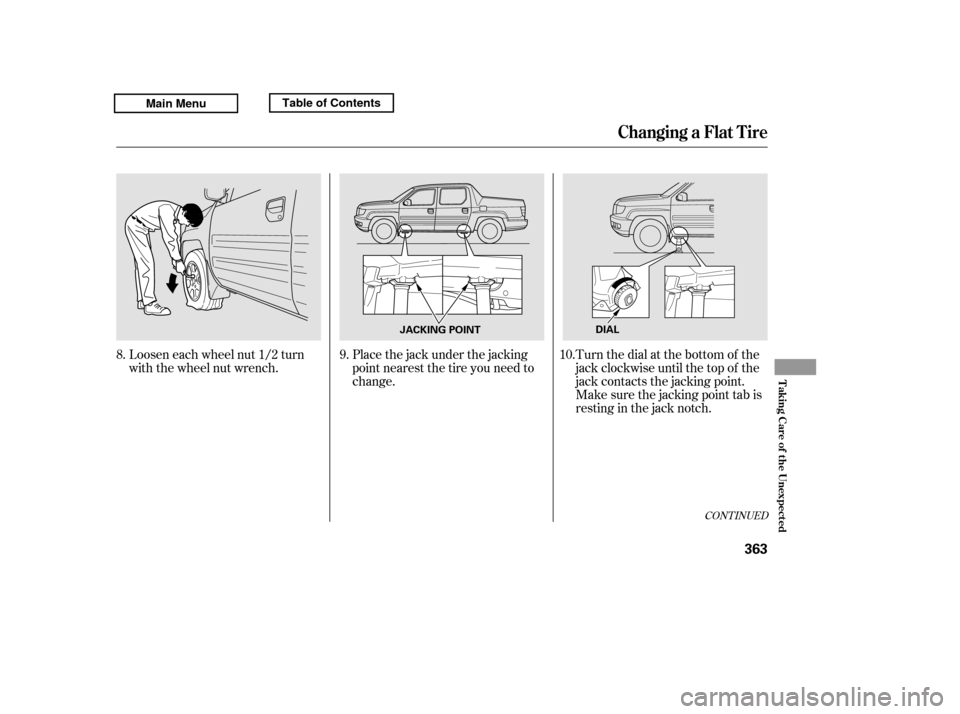
CONT INUED
Loosen each wheel nut 1/2 turn
with the wheel nut wrench.Place the jack under the jacking
point nearest the tire you need to
change.Turn the dial at the bottom of the
jack clockwise until the top of the
jack contacts the jacking point.
Make sure the jacking point tab is
restinginthejacknotch.
8.
9.10.
Changing a Flat T ire
T aking Care of t he Unexpect ed
363
JACKING POINTDIAL
Main MenuTable of Contents
Page 368 of 427
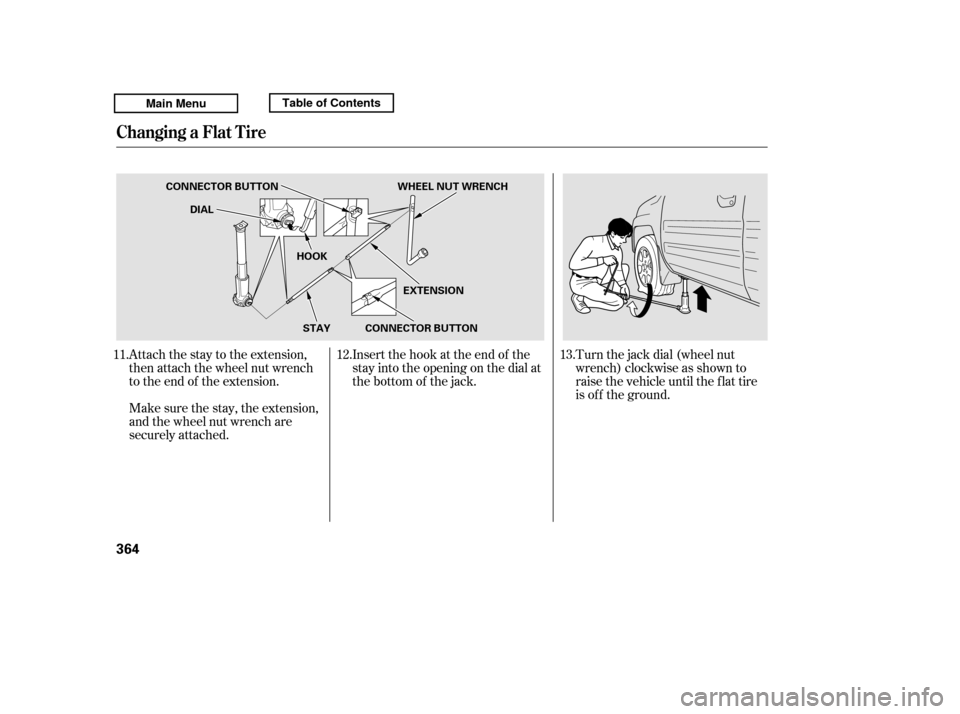
Attach the stay to the extension,
then attach the wheel nut wrench
to the end of the extension.Turn the jack dial (wheel nut
wrench) clockwise as shown to
raise the vehicle until the f lat tire
is of f the ground.
Make sure the stay, the extension,
and the wheel nut wrench are
securely attached. Insert the hook at the end of the
stay into the opening on the dial at
the bottom of the jack.
11. 12. 13.
Changing a Flat T ire
364
EXTENSION
DIAL
CONNECTOR BUTTON
HOOK
STAY WHEEL NUT WRENCH
CONNECTOR BUTTON
Main MenuTable of Contents
Page 369 of 427
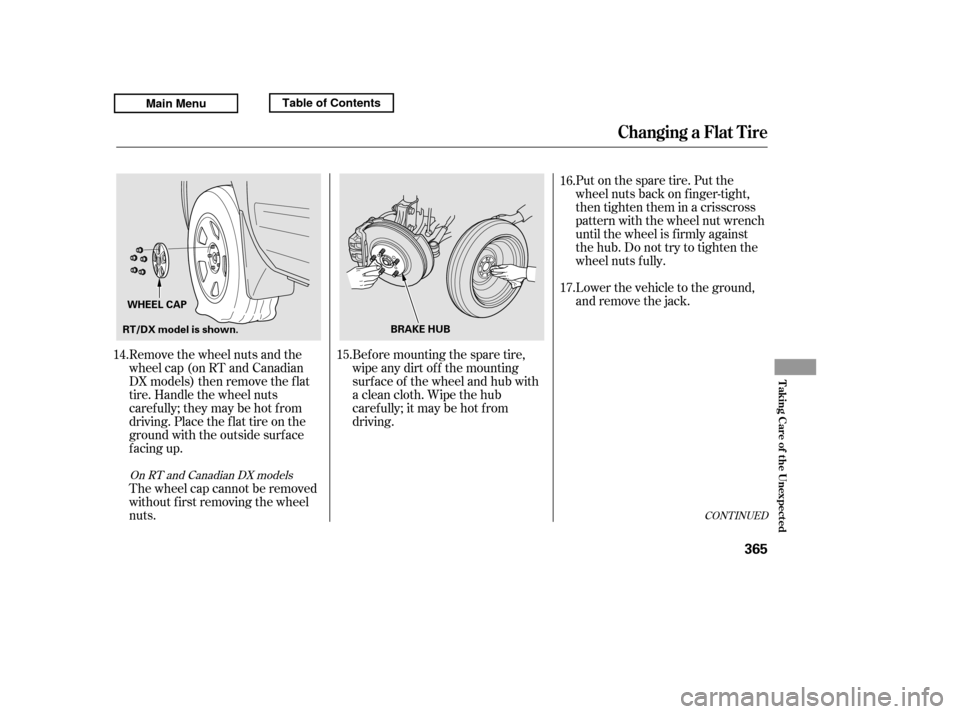
CONT INUED
Put on the spare tire. Put the
wheel nuts back on f inger-tight,
then tighten them in a crisscross
pattern with the wheel nut wrench
until the wheel is f irmly against
the hub. Do not try to tighten the
wheel nuts f ully.
Lower the vehicle to the ground,
and remove the jack.
Bef ore mounting the spare tire,
wipeanydirtoff themounting
surface of the wheel and hub with
a clean cloth. Wipe the hub
carefully;itmaybehotfrom
driving.
The wheel cap cannot be removed
without first removing the wheel
nuts.
Remove the wheel nuts and the
wheel cap (on RT and Canadian
DX models) then remove the f lat
tire. Handle the wheel nuts
caref ully; they may be hot f rom
driving. Place the f lat tire on the
ground with the outside surf ace
f acing up.
14. 15. 16. 17.
On RT and Canadian DX models
Changing a Flat T ire
T aking Care of t he Unexpect ed
365
BRAKE HUB
WHEEL CAP
RT/DX model is shown.
Main MenuTable of Contents
Page 370 of 427
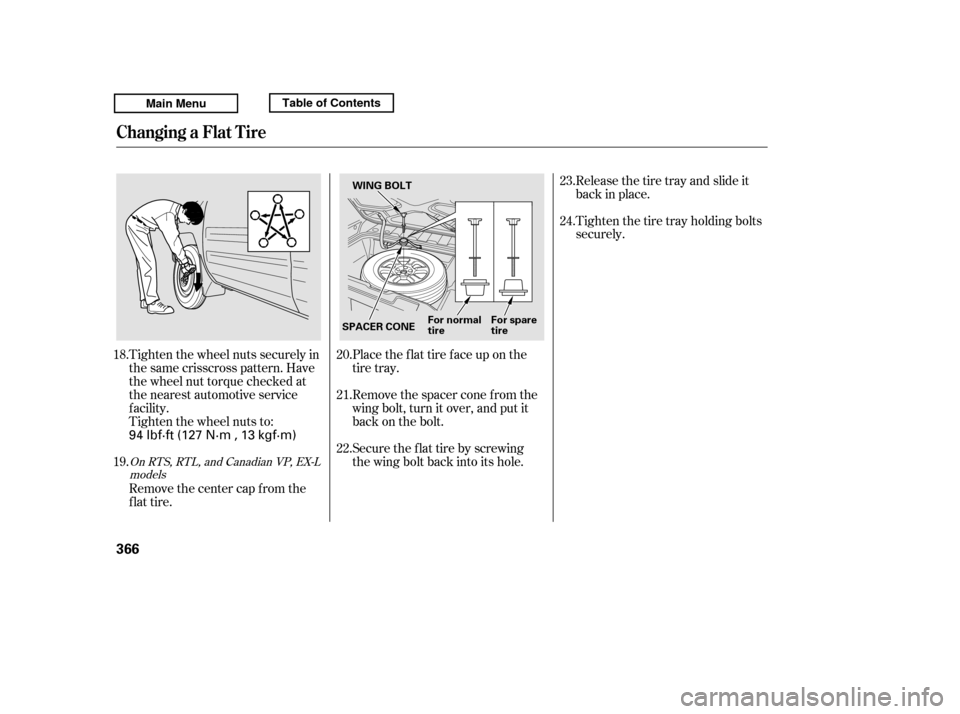
Tighten the wheel nuts securely in
the same crisscross pattern. Have
the wheel nut torque checked at
the nearest automotive service
f acility.
Tighten the wheel nuts to:Place the flat tire face up on the
tire tray.
Remove the spacer cone f rom the
wing bolt, turn it over, and put it
back on the bolt.
Securetheflattirebyscrewing
the wing bolt back into its hole.Release the tire tray and slide it
back in place.
Tighten the tire tray holding bolts
securely.
Remove the center cap from the
flat tire.
18. 19.
20. 21. 22.23. 24.
On RTS, RTL, and Canadian VP, EX-L
models
Changing a Flat T ire
366
WING BOLT
SPACER CONE For normal tireFor sparetire
94 lbf·ft (127 N·m , 13 kgf·m)
Main MenuTable of Contents